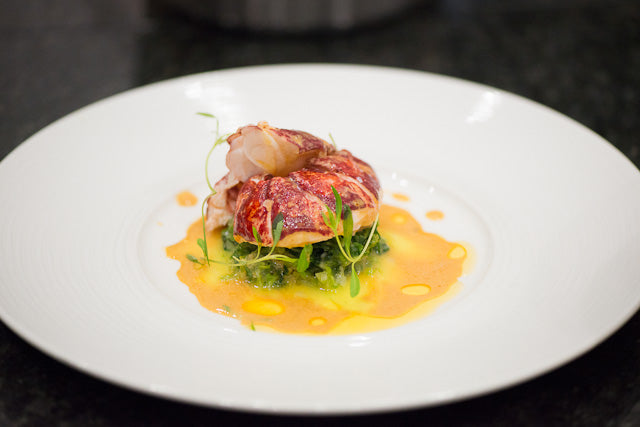How To Make A Tasting Menu At Home
By Nicola Lando
-
November 8th, 2019
-

What Is A Tasting Menu?
When cooks set themselves a challenge, tasting menus are a popular option. It’s a great way to try out new dishes, showcase new flavours and experiment with new techniques – but there are some pit-falls to be aware of.
Bad portioning can leave diners feeling bloated. Lengthy meals can seem strung-out. And confused menus have dishes fighting against each other instead of sitting happily side by side.
What Is A Tasting Menu Meant To Look Like?
Tasting menus take all shapes and forms, some stretching to up to 20 dishes, and some that are much shorter. A Tasting menu should be a journey that takes diners through a range of flavours, and keeps them looking forward to the next dish.
Where Do Chefs Get Tasting Menu Ideas?
Constructing a menu is a science –so much so that Noma chef René Redzepi recently invited psychology professor, Paul Rozin, to advise an audience of top chefs. Off the back of the lecture, we have pinned down five golden rules to help ensure a smooth journey from the first course right through to the end.
1. Small Bites For Tasting Menus
Sending guests home hungry is an age-old fear which often leads to over-compensation. But serving small plates of food is an elegant way of eating, allowing diners to experience more dishes without feeling bloated.
Psychology professor Paul Rozin explains: “If somebody eats one teaspoon of caviar and thinks ‘wow, that’s great’, then their memory of it is the same if they eat three teaspoons.”
Presentation is important though – it bridges the gap between dishes appearing frugal and purposefully-portioned. Try using Japanese rice bowls, sauce dishes and little plates to keep small helpings in proportion.
2. The Right Portion Sizes For Tasting Menus
“Single dishes might work well on their own but, but be too rich or heavy to compliment a tasting menu structure” explains Michelin-starred chef Marc Wilkinson.
Bad portioning can leave diners feeling bloated
A few simple alterations can lighten big plates though. Try serving fish or meat on a bed of seaweed instead of root vegetables. Substitute heavy dressings for more delicate alternatives like Forum vinegar and avoid serving more than one dish which has been cooked in butter or oil.

3. What Order Should A Tasting Menu Be?
Serve heavier plates at the start of a meal when diners have larger appetites. As the taster menu progresses, explore options such as ceviche, granitas and gazpacho as a way of introducing new flavours without overwhelming guests with rich food.
Punctuate the tasting menu with simpler dishes to change the pace and cleanse palettes. A plain, green salad can be a welcome pause when sandwiched between elaborate dishes. Or homemade bread and truffle butter can have a big impact.
4. How To Prepare A Tasting Menu
Choose courses which allow you to do a lot of the preparation in advance. That way the tasting menu will run like lots of short sprints, rather than a marathon dragging into the night. Even dishes like risottos shouldn’t be started from scratch – but can be prepared in advance to keep the pace of a meal moving,
5. How To Present An Entertaining Menu
Heston Blumenthal is the master of mealtime theatrics, from Ipods in conches to billows of smoke and hot-iced-tea. But there are lots of simpler tricks to stop proceedings from getting staid.
Single dishes might work well on their own but, but be too rich or heavy in a tasting menu
Ferran Adrià often moves diners from outside in part-way through the meal to create a ‘second-beginning’. And at Mexico’s Pujol restaurant, guests eat over half of the dishes with their hands. Collectives such as The Disappearing Dining Club hold tasting menus in shops, laundrettes and lofts – where, founder Stuart Langley explains, “It’s about how our guests eat, as much as what our guests eat.” Starters or desserts served inside bottles and jars often get a reaction. Sharing dishes are a good way to encourage interaction, and anything from salt blocks to popping candy to innovative tableware make courses that bit more memorable.
Have you ever attempted a tasting menu? What dishes did you serve? And what tips do you have to share?
The lobster and lamb dishes were cooked by Galton Blackiston at Skills for Chefs in July 2012.
For more menu ideas take a look at our Recipes on The Bureau Of Taste, or for some different cooking methods browse our selection of products for different chef techniques.

About the author
Nicola is co-founder and CEO at Sous Chef. She has worked in food for over ten years.
Nicola first explored cooking as a career when training at Leiths, before spending the next decade in Finance. However... after a stage as a chef at a London Michelin-starred restaurant, Nicola saw the incredible ingredients available only to chefs. And wanted access to them herself. So Sous Chef was born.
Today, Nicola is ingredients buyer and a recipe writer at Sous Chef. She frequently travels internationally to food fairs, and to meet producers. Her cookbook library is vast, and her knowledge of the storecupboard is unrivalled. She tastes thousands of ingredients every year, to select only the best to stock at Sous Chef.
Nicola shares her knowledge of ingredients and writes recipes to showcase those products. Learning from Sous Chef's suppliers and her travels, Nicola writes many of the recipes on the Sous Chef website. Nicola's recipes are big on flavour, where the ingredients truly shine (although that's from someone who cooks for hours each day - so they're rarely tray-bakes!).


